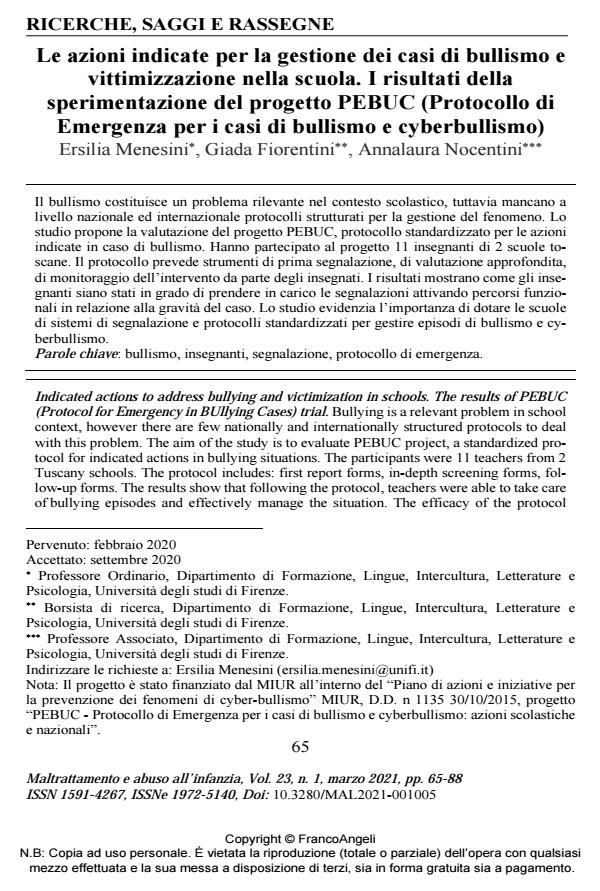Le azioni indicate per la gestione dei casi di bullismo e vittimizzazione nella scuola. I risultati della sperimentazione del progetto PEBUC (Protocollo di Emergenza per i casi di bullismo e cyberbullismo)
Titolo Rivista MALTRATTAMENTO E ABUSO ALL’INFANZIA
Autori/Curatori Ersilia Menesini, Giada Fiorentini, Annalaura Nocentini
Anno di pubblicazione 2021 Fascicolo 2021/1
Lingua Italiano Numero pagine 24 P. 65-88 Dimensione file 257 KB
DOI 10.3280/MAL2021-001005
Il DOI è il codice a barre della proprietà intellettuale: per saperne di più
clicca qui
Qui sotto puoi vedere in anteprima la prima pagina di questo articolo.
Se questo articolo ti interessa, lo puoi acquistare (e scaricare in formato pdf) seguendo le facili indicazioni per acquistare il download credit. Acquista Download Credits per scaricare questo Articolo in formato PDF

FrancoAngeli è membro della Publishers International Linking Association, Inc (PILA)associazione indipendente e non profit per facilitare (attraverso i servizi tecnologici implementati da CrossRef.org) l’accesso degli studiosi ai contenuti digitali nelle pubblicazioni professionali e scientifiche
Il bullismo costituisce un problema rilevante nel contesto scolastico, tuttavia mancano a li-vello nazionale ed internazionale protocolli strutturati per la gestione del fenomeno. Lo stu-dio propone la valutazione del progetto PEBUC, protocollo standardizzato per le azioni in-dicate in caso di bullismo. Hanno partecipato al progetto 11 insegnanti di 2 scuole toscane. Il protocollo prevede strumenti di prima segnalazione, di valutazione approfondita, di moni-toraggio dell’intervento da parte degli insegnati. I risultati mostrano come gli insegnanti sia-no stati in grado di prendere in carico le segnalazioni attivando percorsi funzionali in rela-zione alla gravità del caso. Lo studio evidenzia l’importanza di dotare le scuole di sistemi di segnalazione e protocolli standardizzati per gestire episodi di bullismo e cyberbullismo.
Parole chiave:Bullismo, insegnanti, segnalazione, protocollo di emergenza.
- Indicated Interventions for Youth Involved in Bullying and Victimization Behaviors: A Systematic Review Nocentini Annalaura, Taddei Benedetta, De Luca Lisa, Menesini Ersilia, in Adolescent Research Review /2025 pp.403
DOI: 10.1007/s40894-024-00255-x - Finché le cose non andranno meglio: discriminazione di genere e slut-shaming nell'esperienza di un gruppo di giovani donne Paola Miano, Chiara Urone, in MALTRATTAMENTO E ABUSO ALL'INFANZIA 1/2025 pp.101
DOI: 10.3280/MAL2025-001006
Ersilia Menesini, Giada Fiorentini, Annalaura Nocentini, Le azioni indicate per la gestione dei casi di bullismo e vittimizzazione nella scuola. I risultati della sperimentazione del progetto PEBUC (Protocollo di Emergenza per i casi di bullismo e cyberbullismo) in "MALTRATTAMENTO E ABUSO ALL’INFANZIA" 1/2021, pp 65-88, DOI: 10.3280/MAL2021-001005